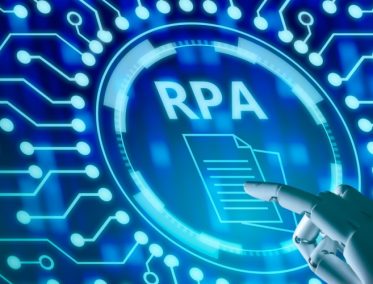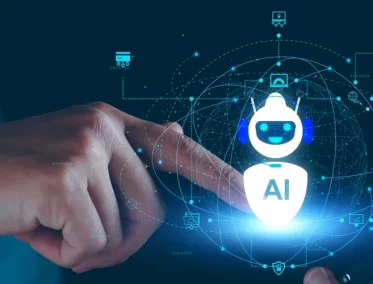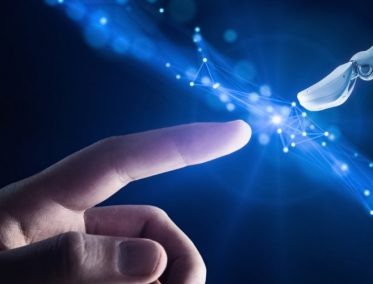In an era defined by rapid technological advancement and digital transformation, two technological forces have emerged as pivotal in reshaping the landscape of modern businesses: Artificial Intelligence (AI) and Robotic Process Automation (RPA). These technologies, once considered separate domains, are now converging, creating a synergy that is driving unprecedented levels of innovation and efficiency in the corporate world.
AI, with its ability to mimic human intelligence and decision-making, has revolutionized the way businesses interact with data and extract insights. It has opened doors to predictive analytics, intelligent decision-making, and personalized customer experiences. On the other hand, RPA has made significant strides in automating routine and repetitive tasks, allowing businesses to streamline operations, reduce errors, and free up valuable human resources for more strategic initiatives.
As we delve into this discussion, it’s crucial to understand how the integration of AI and RPA is not just an enhancement of capabilities but a transformative movement in the business world. This combination, often referred to as Intelligent Automation, is redefining what automation means – turning it from a tool for cost reduction into a driver of innovation and strategic growth. In this article, we will explore how AI and RPA are working together, the innovations they are fostering, and the impact they are having across various industry sectors.
Understanding AI and RPA
In the dynamic world of technology, AI and RPA stand out as two of the most influential developments. Understanding how AI and RPA work together and how they differ, will help users appreciate their combined power.
Artificial Intelligence
Artificial Intelligence refers to the simulation of human intelligence in machines. These AI systems are designed to think like humans and mimic their actions, encompassing learning, reasoning, problem-solving, perception, and language understanding.
Capabilities of AI
- Learning and Adaptation: AI systems can learn from data and experiences, adapting to new inputs and changes in their environment.
- Decision Making: AI excels at making informed decisions by analyzing large volumes of data, identifying patterns, and predicting outcomes.
- Natural Language Processing: AI can understand and interpret human language, facilitating interactions between humans and machines, as seen in chatbots and virtual assistants.
- Problem Solving: AI can tackle complex problems, offering solutions that might be challenging or time-consuming for human beings.
Robotic Process Automation: Definition and Primary Functions
Robotic Process Automation involves using software robots or ‘bots’ to automate routine, rule-based tasks that are usually performed by human workers. These bots interact with digital systems and software to execute business processes.
- Primary Functions of RPA:
- Task Automation: RPA bots can handle tasks like data entry, invoice processing, and email responses, automating repetitive and time-consuming work.
- Workflow Management: RPA can manage workflows by routing information to the right systems and stakeholders, ensuring smooth operational processes.
- Data Manipulation: These bots can extract, organize, and process data, facilitating data-driven business processes.
Differences and Individual Strengths of AI and RPA
AI is designed for tasks that require cognitive abilities and decision-making, whereas RPA is best suited for repetitive, rule-based tasks that don’t require complex decision-making.
- Learning and Adaptability: AI systems can learn and adapt over time, improving their performance and capabilities, while RPA bots follow predefined rules and processes.
- Complexity and Application: AI can handle complex tasks involving unstructured data and natural language, making it ideal for applications like customer service, predictive analytics, and personalized recommendations. In contrast, RPA is more focused on structured tasks in defined environments, such as back-office processes and data management.
How Do AI and RPA Work Together: The Synergy
The integration of Artificial Intelligence and Robotic Process Automation marks a significant milestone in the evolution of business automation. This synergy, often termed as Intelligent Automation, capitalizes on the strengths of both technologies to create systems that are not only efficient but also intelligent and adaptive. Understanding how AI and RPA complement each other reveals the immense potential of this blend in revolutionizing business processes.
Complementary Nature of AI and RPA
- Enhanced Decision-Making: RPA, in its traditional form, follows predefined rules and lacks decision-making capabilities. AI fills this gap by providing the cognitive ability to analyze complex data, make informed decisions, and learn from outcomes. This combination allows for the automation of more complex tasks that require both action and decision-making.
- Increased Scope of Automation: While RPA is excellent at handling structured data, AI extends this capability to unstructured data, such as text, images, and speech. This broadens the scope of automation to include tasks like data interpretation, sentiment analysis, and natural language processing.
- Adaptive and Scalable Solutions: The incorporation of AI into RPA solutions allows for more adaptable and scalable automation. AI algorithms can learn and evolve, enabling the automation system to improve over time and adapt to changing business environments.
Intelligent Automation: The Blend of AI and RPA
Intelligent Automation represents the fusion of AI’s cognitive capabilities with RPA’s efficiency. It’s a holistic approach to automation that encompasses learning, analyzing, and decision-making, alongside executing routine tasks.
- Enhancing RPA with AI: Integrating AI technologies like machine learning, natural language processing, and computer vision into RPA systems elevates the functionality of bots from rule-based tasks to more intelligent operations.
- Dynamic Process Optimization: Intelligent Automation enables dynamic optimization of processes. It allows businesses to automate complex workflows that require both repetitive actions and cognitive input, leading to greater efficiency and accuracy.
Examples of AI-Enhanced RPA Automation
- Customer Service Chatbots: AI-powered chatbots integrated with RPA can handle customer queries, provide personalized responses, and perform backend tasks like updating records or processing orders, offering a comprehensive customer service solution.
- Financial Data Analysis: In finance, AI can analyze market trends and company performance, while RPA automates routine financial operations like data entry and report generation, resulting in efficient and insightful financial analysis.
- Healthcare Patient Management: In healthcare, AI can assist in diagnosing and recommending treatment plans, while RPA takes care of administrative tasks like patient scheduling and record maintenance.
AI and RPA Integration Challenges and Solutions
Integrating Artificial Intelligence with Robotic Process Automation can unlock tremendous value for businesses, but it’s not without its challenges. These challenges range from technical issues like data quality and system compatibility to strategic concerns such as aligning AI and RPA with business objectives. This section explores these common hurdles and offers strategies to effectively overcome them.
Common Challenges
- Data Quality and Accessibility: High-quality, accessible data is crucial for AI algorithms to function effectively. However, businesses often struggle with fragmented or poor-quality data, which can impede the effectiveness of AI-enhanced RPA solutions.
- Strategy: Implement robust data governance practices to ensure data quality and accessibility. This involves standardizing data collection processes, ensuring data accuracy, and making data readily available for AI and RPA applications.
- System Compatibility and Integration: Integrating AI with existing RPA setups and other business systems can be challenging due to compatibility issues, legacy systems, or different technology stacks.
- Strategy: Conduct a thorough assessment of current systems and infrastructure. Choose AI and RPA solutions that are known for their interoperability and offer flexible integration capabilities. Employ middleware or API-based integrations to bridge gaps between disparate systems.
- Balancing Automation and Human Oversight: Finding the right balance between automation and human intervention is critical. Over-reliance on automation can lead to oversight of complex issues that require human judgment.
- Strategy: Establish clear guidelines on the roles of AI and RPA in business processes. Maintain a system of checks and balances where automated solutions are regularly monitored and supplemented by human decision-making where necessary.
- Skill Gaps and Training Needs: The successful implementation of AI and RPA integration often requires skills that may not be present in the existing workforce.
- Strategy: Invest in training programs to upskill employees in AI and RPA-related technologies. Consider hiring or collaborating with experts in the field to fill immediate skill gaps.
Strategies to Overcome the Challenges
- Phased Implementation Approach: Adopt a phased approach to integration, starting with smaller, manageable projects before scaling up. This allows for the identification and resolution of issues in the early stages.
- Tactic: Begin with pilot projects that demonstrate the potential of AI and RPA integration, then gradually expand to more complex applications as confidence and expertise grow.
- Strong Collaboration Between IT and Business Units: Encourage collaboration between IT departments and business units to ensure that the AI and RPA integration aligns with business goals and operational needs.
- Tactic: Establish cross-functional teams that include IT specialists, business analysts, and end-users to guide the integration process.
- Continuous Monitoring and Optimization: AI and RPA integrations require ongoing monitoring and optimization to ensure they continue to meet business needs effectively.
- Tactic: Implement continuous monitoring tools and conduct regular reviews to assess the performance of AI-RPA systems and identify areas for improvement.
The Future of How Do AI and RPA Work Together
As businesses continue to navigate the digital landscape, the integration of Artificial Intelligence and Robotic Process Automation is poised to create more profound impacts across various industries. Understanding the future trends and potential advancements in these technologies can help organizations stay ahead of the curve and fully harness their transformative power.
Predicting Future Trends in AI and RPA Integration
- Greater Cognitive Capabilities: Future AI advancements are expected to bring enhanced cognitive capabilities to RPA, enabling bots to handle more complex decision-making and problem-solving tasks. This will likely broaden the scope of automation to include processes that require sophisticated analyses and judgments.
- Hyper-Automation: The trend towards hyper-automation, where businesses automate as many processes as possible, is expected to gain momentum. AI and RPA will play a central role in this movement, driving the creation of highly efficient, automated digital ecosystems.
- Seamless Human-AI Collaboration: The future will see more seamless collaboration between humans and AI-enhanced RPA systems. This collaboration will focus on complementing human creativity and strategic thinking with the efficiency and accuracy of AI-RPA systems.
Potential Impact of AI and RPA on Different Industries
- Healthcare: In healthcare, AI and RPA integration can revolutionize patient care management, from automated patient scheduling and billing to AI-driven diagnostics and personalized treatment plans.
- Finance and Banking: The finance sector may see significant advancements in fraud detection, risk assessment, and customer service optimization, with AI and RPA offering more secure, efficient, and personalized financial services.
- Manufacturing and Supply Chain: In manufacturing and supply chain, AI and RPA can lead to smarter inventory management, predictive maintenance, and optimized logistics, enhancing operational efficiency and reducing costs.
Advancements to Watch for in AI and RPA Technologies
- Enhanced Learning Algorithms: The development of more sophisticated machine learning algorithms is expected, which will enable RPA bots to learn and adapt to new tasks and environments more quickly and effectively.
- Improved Natural Language Processing: Advances in natural language processing (NLP) will allow for more nuanced and complex interactions between AI systems and human language, enhancing the capabilities of AI in understanding and responding to human inputs.
- Integration with IoT and Edge Computing: The integration of AI and RPA with IoT (Internet of Things) and edge computing is likely to grow, allowing for real-time data processing and automation in a broader range of contexts, including remote and mobile environments.
- Autonomous Decision-Making: Future developments may enable AI-enhanced RPA systems to make autonomous decisions based on real-time data and predictive analytics, further reducing the need for human intervention in routine processes.
Getting Started AI and RPA Integration
Integrating Artificial Intelligence with Robotic Process Automation is a strategic move that can significantly enhance business operations. However, for many organizations, embarking on this journey can seem daunting.
Guidelines
- Assess Your Business Needs: Begin by identifying the areas within your business that could benefit most from automation. Look for processes that are repetitive, time-consuming, and prone to human error. Consider how AI can add value, perhaps through enhanced decision-making, data analysis, or customer interaction.
- Start Small and Scale Up: It’s advisable to start with a small, manageable project. This approach allows you to test the waters, understand the integration complexities, and gauge the impact before scaling up to more complex systems.
- Build a Skilled Team: Assemble a team with the right mix of skills. This team should ideally include members with expertise in AI, RPA, data analysis, and project management. If such skills are not available in-house, consider hiring new talent or upskilling existing employees.
- Prioritize Data Management: Good data is the lifeblood of effective AI-RPA integration. Ensure that you have access to high-quality, relevant data and that your data management practices are up to the mark in terms of accuracy, consistency, and accessibility.
Tips on Selecting the Right Tools and Partners
The market is replete with AI and RPA tools, each offering different features and capabilities. Evaluate tools based on how well they align with your business processes, the level of customization they offer, and their ease of integration.
Opt for solutions that are scalable and flexible. As your business grows and evolves, your AI and RPA solutions should be able to adapt to changing needs and scale accordingly.
Choose vendors that offer robust support and have an active user community. Good vendor support can be invaluable during the integration process, and a vibrant community can provide additional insights and troubleshooting assistance.
Collaborating with experienced partners can significantly smooth out the integration process. Look for partners or consultants who have a proven track record in implementing AI and RPA solutions in your industry.
Once the tools are selected, invest in training your team to ensure they are equipped to use the new systems effectively. Continuous learning should be encouraged to keep up with the evolving nature of these technologies.
The integration of AI and RPA heralds a future where automation extends beyond routine tasks to encompass complex decision-making and problem-solving capabilities. This evolution paves the way for businesses to not only optimize efficiency and reduce costs but also to unlock new opportunities for innovation and strategic growth. With AI-enhanced RPA, organizations can tackle more intricate tasks, gain deeper insights from their data, and offer more personalized and effective services to their customers.
Looking ahead, the potential impacts of AI and RPA integration span across industries, reshaping everything from healthcare and finance to manufacturing and customer service. This integration promises to bring about smarter, more responsive, and adaptive business solutions. As these technologies continue to advance and mature, we can expect to see even more innovative applications and solutions emerging.




